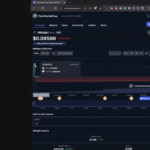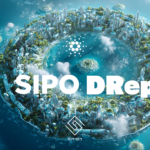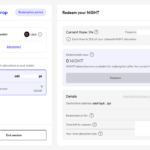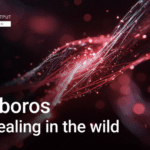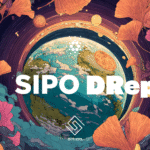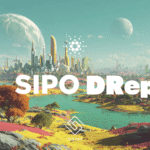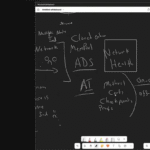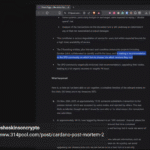Cardanoレイヤー2の最前線:「Hydraのその先」へ──多層的スケーリング戦略と開発者たちの挑戦
2025年6月、IOGの研究部門であるInput Output Research(IOR)は、Intersect Research Working Groupとともに、「Layer 2 Expansion: Beyond Hydra」と題した特別セッションを開催しました。本イベントは、Cardanoのスケーリングに向けた最新技術と思想を一望できる貴重な機会となり、Hydraを超えて進化するレイヤー2(L2)構築の最前線が明らかになりました。
🧠 Hydraの再定義:オフチェーンの最適化と分散チャネルの未来
セッション冒頭では、IORのサンドロ・コレッティ=ドレイトン氏が、Hydraの設計と研究進捗を包括的に報告。Hydraは単なるスケーリングツールではなく、状態チャネルとロールアップを橋渡しする構造的アプローチをとる、Cardanoに最適化されたL2ファミリーです。
- Hydra Head:少人数での高速処理用ステートチャネル
- Hydra Tail:ロールアップに近い大規模スケーリング型
さらに、Inter-Head通信やルーティング最適化ツール、監査可能なメトリクス設計など、透明性と相互接続性を重視した次世代Hydraの姿が語られました。
🚀 多様なアプローチが躍動:新興レイヤー2プロジェクト紹介
プレゼンテーション後のパネルディスカッションでは、Cardanoエコシステムを代表する開発者たちが登壇。それぞれがEUTXOモデルを活かした革新的なL2設計を披露しました。
✅ Anastasia Labs「Midgard」
OptimismやFuelを参考に設計されたオプティミスティック・ロールアップ。決定論的fraud proofを採用し、ガバナンスマルチシグへの依存を最小化。年内MVPローンチを目指します。
✅ zkFold「zkFold Rollup」
ZKロールアップにより、数百のトランザクションを1件のL1提出に圧縮。プライバシー保護と高速確定性を両立し、スマートコントラクト対応も視野に。
✅ Eryx「ZKブリッジ」
ZcashやStarkNetの知見を活かし、Cardano上にネイティブなZKクロスチェーンブリッジを構築。監査可能で安全な相互運用性を目指します。
✅ Sundae Labs「Gummiworm」
Hydraに触発された水平スケーラブルなロールアップ。custodyとexecutionを分離し、複数のヘッド間でのアトミック処理も可能に。
🔗 相互運用性と経済設計:「競争」ではなく「協調」へ
ディスカッションで共通していたのは、**「標準化されたインターフェース」と「レイヤー2同士の協調」**を軸に据える姿勢でした。
- EthereumのようなL2分断を避けるため、共通の仕様に基づく接続性が必須
- 資本効率の低下を防ぐために、流動性の連携・UX改善・プロトコル統合が提案されました
CardanoのEUTXOモデルはその構造上、複数L2が安全かつ独立して共存・連携可能な構成を可能にしており、これは他のブロックチェーンにはない明確な強みです。
🔐 セキュリティとZK文化の育成
セキュリティの重要性も強調されました。IORは数学的保証に基づく安全設計を重視し、EryxはCardano内にZK開発者・監査人コミュニティを育てる必要性を訴えました。
ZK技術は極めて強力ですが、正しく使われなければ逆にリスクともなり得るため、教育・協働による監査文化の形成が不可欠です。
🔮 展望:Cardanoの未来を形作るのは「多様性」と「連携」
パネリストたちは口を揃えて、「Cardanoのスケーリングは単一の勝者モデルではない」と述べました。
重要なのは、性能・用途・設計思想が異なるレイヤー2ソリューションが互いに補完しあいながら、全体としての強靭性と拡張性を支えていくことです。
- サンドロ氏:プロトコル安全性の形式検証を推進
- フィリップ氏:L1手数料モデルの限界を補うL2スループット
- ウラジミール氏:ブロブ・バッチ処理での帯域拡張
- カロリーナ氏:ZKアプリにとって理想的なCardano環境
- パイ氏:開発者同士の「シェアして共に創る」文化
🧭 結論:Cardano 2.0への核心──Hydraだけではない、多元的L2の力
「Hydraを超えたレイヤー2拡張」セッションは、Cardanoが多様なL2を包摂することでスケーリングの地平を切り拓いていることを示しました。
コミュニティ主導のイノベーション、オープンスタンダード、相互接続可能なインフラ──
これらが整うことで、分散型で高性能な未来型ブロックチェーンとしてのCardanoの進化はますます加速していくでしょう。
🔗 Cardanoは、競争によってではなく、協調によって進化する──その設計思想が明確に現れた1時間だった。
以下はIOGが公開した記事「Layer 2 expansion: beyond Hydra」を翻訳したものです。
Hydraを超えたレイヤー2の拡張
出典:Input | Output Research(IOR)、Intersect Research Working Groupとの共催、2025年6月24日、執筆:Fergie Miller
IOR(Input Output Research)は、CardanoのR&D(研究開発)セッションを「Hydraを超えたレイヤー2の拡張」というテーマで、Intersect Research Working Groupと共同で2025年6月に開催しました。このセッションでは、Cardanoエコシステム全体から集まったトップクラスの開発者や研究者が参加し、楽観的ロールアップ、ゼロ知識ロールアップ、そしてHydraにインスパイアされた新たなアーキテクチャに至るまで、次世代のレイヤー2イノベーションを探求しました。
コミュニティとの協調による研究開発
IORは、2025年Cardano予算キャンペーンで寄せられたコミュニティのフィードバックを受けて、Intersect Research Working Groupの月例ミーティングを、より動的でテーマ別のオープンイベントへと再編しました。
6月のイベントでは、Anastasia Labs、zkFold SA、Eryx、Sundae Labs、IORの開発者と研究者が集結し、各自のレイヤー2プロジェクトに関する知見を共有しました。その後、IORのリサーチ・パートナーシップディレクターであるファーギー・ミラー氏の司会による円卓ディスカッションが行われました。
Hydraとレイヤー2の全体像
セッションはまず、IORのリサーチフェローであるサンドロ・コレッティ=ドレイトン氏による、Hydraの進化する役割に関する詳細なプレゼンテーションで幕を開けました。
Hydraは、Cardanoのスケーリング戦略における中核を担うものであり、レイヤー1のセキュリティ保証と確定的な決済性を維持しながら、オフチェーンでのスケーラブルなトランザクション処理を可能にすることを目的としています。
サンドロは、Hydraファミリーの2つの主要な設計を紹介しました:
- Hydraヘッド:固定された少人数の参加者によるステートチャネル型プロトコル。迅速なオフチェーン処理と共有制御が可能。
- Hydraテイル:ロールアップに着想を得たモデルで、中央のオペレーターによって管理され、高スループットを求めるアプリケーション向けに広範なスケーラビリティを提供。
さらに、現在進行中の研究として以下が挙げられました:
- Hydra Headの形式検証:Universal Composability(UC)フレームワークを用いてセキュリティとプロトコルのモジュール性を証明。
- Hydra Inter-Head:複数のHydra Headを接続し、それらの間で仮想チャネルを形成する仕組み。これにより多人数ネットワークの基礎が構築される。
ステートチャネル最適化と監査ツール
続いて、Hydraの新たな研究分野として ステートチャネルネットワーク最適化ツール が紹介されました。これは複数のHydra Headを組み合わせる際に、効率的なトポロジーやルーティング設計を行うことで、パフォーマンス最大化、遅延最小化、参加者間の強固な連携を実現することを目的としています。
さらに、オフチェーンプロトコルにおける透明性の課題にも言及。これを解決するために、「監査ツール(Auditing Tools)」の開発が進められています。これは、トランザクションの個別データを開示することなく、取引量や頻度などの高レベルな指標を監査人が確認できるようにする軽量メカニズムです。
将来的には、非集約的統計の監査対応や動的な監査ポリシーの設定なども視野に入れています。
パネルディスカッションのハイライト:Hydraを超えたスケーリング
サンドロのプレゼンテーションに続いて行われたパネルディスカッションには、Cardanoの新興レイヤー2エコシステムで活躍する開発者たちが登壇し、それぞれがスケーラビリティ、ユーザビリティ、セキュリティの課題解決に向けた独自のアプローチを紹介しました。
全員に共通していたのは、「Cardanoの性能とアクセシビリティを向上させる」という使命。しかし、それぞれが異なる技術的戦略を採っており、Cardanoの拡張UTXO(EUTXO)モデルがいかに多様なレイヤー2構成を支えられるかが際立ちました。
Anastasia Labs:Midgard(オプティミスティック・ロールアップ)
Anastasia Labs の フィリップ・ディサーロ氏 は、「Midgard」というOptimismやFuelに着想を得たオプティミスティック・ロールアップを紹介しました。これはCardanoのEUTXOモデルに適合するように設計されています。
Midgardの特徴は以下の通りです:
- 決定論的な不正検証(fraud proof)の設計
- ガバナンス・マルチシグ(多署名)への依存を最小限に抑制
- 技術仕様はすでにオープンソース化済み
- 2025年末までにメインネット対応MVPのリリースを目指す
zkFold SA:Cardano向けZKロールアップ
zkFold SA の ウラジミール・シニャコフ氏 は、「zkFold」というZKロールアップ技術を紹介しました。これは数百のトランザクションを1つのレイヤー1提出に圧縮する手法です。
zkFoldの主な利点:
- 高度なプライバシーと効率性
- ほぼ即時のファイナリティ(決済確定性)
- ネットワーク負荷の大幅な削減
ウラジミール氏によると、2025年末までにテストネットに到達し、その後にスマートコントラクト完全対応が予定されています。
Eryx Cooperativa:ZKブリッジ・プロトコル
Eryxの カロリーナ・ラング氏 は、Cardano上にZKブリッジを組み込む構想を発表しました。これは、同形的(isomorphic)なチェーン間通信を可能にするもので、ZcashやStarkNetなどで培った暗号工学の豊富な経験を基に、オープンソースかつモジュール型のクロスチェーン相互運用プロトコルとして開発中です。
EryxのZKブリッジは以下を志向:
- 安全かつ監査可能なチェーン間通信
- CardanoにおけるZK機能の基盤構築
- 高度な相互運用性の実現
Sundae Labs:Gummiworm(Hydraインスパイア型ロールアップ)
Sundae Labs の パイ・ラニングハム氏 は、「Gummiworm」という水平スケーラブルなロールアップシステムを紹介しました。
このプロトコルの特徴は以下の通りです:
- トランザクション処理と資産管理の分離(custodyとexecutionの分離)
- 複数のHydraヘッドを横断するアトミックトランザクション
- 最先端の暗号理論よりも実用的な暗号技術に焦点
- DeFi向けユースケースを意識した設計
円卓ディスカッション:相互運用性、経済設計、協調、安全性
ディスカッション全体を通じて繰り返し取り上げられたテーマのひとつが、相互運用性(interoperability) でした。
Anastasia Labsのフィリップ・ディサーロ氏とzkFoldのウラジミール・シニャコフ氏は、ともにCardanoのレイヤー2全体に標準化されたインターフェース層の必要性を強調しました。これは、イーサリアムの分断されたスケーリング・エコシステムから得た重要な教訓に基づくものです。
パネリストたちは、レイヤー2同士が支配権を争う競争関係になるのではなく、それぞれのユースケースに最適化されたソリューションをポートフォリオ的に共存させるべきという点で意見が一致しました。例えば:
- DeFi
- プライバシー
- 高スループットのアプリケーション
これらを共通の標準によって支え、クロスプロトコルでのシームレスな連携を実現することが目標です。
経済設計と資本効率の課題
次に議論されたのは、レイヤー2の経済設計でした。
Sundae Labsのパイ・ラニングハム氏は、ユーザーがプロトコルごとに資産をロックする必要があることで発生する**資本の分断(capital fragmentation)**が、採用の大きな障壁になっていると指摘しました。
これを解決するために挙げられた提案:
- 流動性ボンディング(liquidity bonding) の仕組み
- ユーザー体験(UX)の改善
- 異なるプロトコル間での深い統合
こうしたメカニズムによって、資本の効率を維持しながら、相互運用可能なチャンスを創出できます。
パネリストたちは一致して、こうした経済的インセンティブはユーザーだけでなく、開発者やオペレーターにとっても適切に設計されるべきであり、それが活気あるレイヤー2エコシステムの持続に不可欠だと述べました。
セキュリティとZKコミュニティの必要性
次に焦点が当てられたのが、セキュリティです。
IORのサンドロ氏は、プロトコルに対して厳密に定義された性質と**数学的に証明可能な保証(provable guarantees)**が必要であることを強調しました。特に、より多くの価値やインフラレベルのトランザクションを扱うようになるにつれ、この点は重要度を増します。
Eryxのカロリーナ氏は、Cardano内でのZK(ゼロ知識)コミュニティの構築の必要性に触れました。これは実装と監査の両面でのサポートを目的としたものであり、協調的なセキュリティレビューと教育活動が、リスクの低減と信頼性の向上において重要な役割を果たすと述べました。
協調が導くCardanoの多層構造
パネリストたちは最後に、競争ではなく協調によって形作られるCardanoの多層構造の重要性について振り返りました。
Cardanoはスケーリング戦略において**多元主義的アプローチ(pluralistic approach)**を採っており、EUTXOモデルがもたらす安全でモジュール的なレイヤー2構築の独自性を活かす方向性が再確認されました。
しかし、その潜在力が完全に発揮されるのは、以下が実現されたときだと強調されました:
- コミュニティ主導のイノベーション
- 共有インフラ
- オープンな標準規格
結論として、Cardanoのスケーリングロードマップは「一つの勝者を決める競争」ではなく、「多様なレイヤー2が共存・連携しながら発展する基盤」を築くことにあるというビジョンが強調されました。
今後の展望:Cardanoにおけるレイヤー2の未来
ディスカッションの締めくくりとして、パネリストたちは今後3〜5年にわたるCardanoの進化についての展望を語りました。
- サンドロ・コレッティ=ドレイトン氏(IOR)は、レイヤー2プロトコルにおける厳密なセキュリティ分析の深化を目指すと述べました。Cardanoの信頼性と安全性を将来にわたって維持するためには、数学的証明に基づいた形式手法が不可欠です。
- フィリップ・ディサーロ氏(Anastasia Labs)は、レイヤー1の手数料モデルの持続可能性に課題があると指摘しました。これに対処する方法として、スケーラブルなレイヤー2のスループットが収益構造を補完し得ることを強調しました。
- ウラジミール・シニャコフ氏(zkFold SA)は、ブロブ(blob)とバッチ処理(batching)の技術が、分散性を維持しつつ帯域幅の拡張を可能にする役割を担うと述べました。
- カロリーナ・ラング氏(Eryx)は、Cardanoが持つZK技術との高い親和性を評価しました。これは、形式検証を重視する文化と、EUTXOモデルの構造によって支えられており、ZKベースのアプリケーションにとって理想的な土壌であると述べました。
- パイ・ラニングハム氏(Sundae Labs)は、Cardanoにおける開発者の協調的なマインドセットこそが他のエコシステムと一線を画す最大の特徴であると述べました。開発者たちは、知識と成果を共有し、共に築いていく文化を重視していると語りました。
総括:Hydraを超えたレイヤー2拡張の意味
この「Hydraを超えたレイヤー2拡張」セッションが示したのは、Cardanoのスケーリングの未来は、単一のプロトコルによって定義されるものではないということです。むしろ、互換性を持つ多様なレイヤー2ソリューションの星座によって形づくられ、それぞれが性能・プライバシー・使いやすさの観点から異なる強みをもたらします。
IORおよびIntersect Research Working Groupは、こうしたエコシステム全体の協働を今後も支援していくことを表明しています。
- 新たなプロトコルが次々と登場し
- パートナーシップも一層深まり
- Cardanoは分散型かつ高性能なブロックチェーン基盤の次なる段階へとリードする立場を確固たるものにしています
Layer 2 expansion: beyond Hydra
Input | Output Research (IOR) hosted June’s Cardano R&D session in collaboration with the Intersect Research Working Group. Featuring leading developers and researchers from across the ecosystem, together they explored a new generation of layer 2 innovations, from optimistic and zero-knowledge rollups to enhanced Hydra-inspired architectures
June 24, 2025 Fergie Miller 6 mins read
https://youtube.com/watch?v=LnutPfrIxJQ%3Fcc_load_policy%3D0%26cc_lang_pref%3Den%26modestbranding%3D1%26rel%3D0%26enablejsapi%3D1%26origin%3Dhttps%253A%252F%252Fiohk.io%26widgetid%3D1%26forigin%3Dhttps%253A%252F%252Fiohk.io%252Fen%252Fblog%252Fposts%252F2025%252F06%252F24%252Flayer-2-expansion-beyond-hydra%252F%26aoriginsup%3D1%26gporigin%3Dhttps%253A%252F%252Fiohk.io%252Fen%252Fblog%252Fposts%252F2025%252F06%252F24%252Flayer-2-expansion-beyond-hydra%252F%253F__cf_chl_tk%253D9I0yoSQhhTRSVhUKvvyz8j5x5uMO4dXoAgVOP7gZJFU-1750897554-1.0.1.1-s7tU62X.4er6CfaEkzc8C.bMasJ7gebA7f8bFZ6KX20%26vf%3D6
As part of its evolving approach to community collaboration, IOR hosted the June 2025 Cardano R&D session as a thematic, livestreamed panel discussion on Layer 2 Expansion: Beyond Hydra. The event spotlighted a series of leading layer 2 innovations being developed across the Cardano ecosystem, exploring scaling solutions that extend far beyond the Hydra Head protocol.
IOR has rejigged the monthly Intersect Research Working Group meetings as dynamic, thematic open events in response to community feedback during the 2025 Cardano Budget campaign. The June event brought together developers and researchers from Anastasia Labs, zkFold SA, Eryx, Sundae Labs, and IOR to share insights on their respective layer 2 initiatives, followed by a roundtable discussion moderated by Fergie Miller, IOR’s Director of Research Partnerships.
Hydra and the layer 2 landscape
The session opened with an in-depth presentation from Sandro Coretti-Drayton, research fellow at IOR, who provided a comprehensive update on Hydra’s evolving role within Cardano’s scaling strategy. As a key pillar of the Cardano Vision research agenda, Hydra aims to deliver scalable off-chain transaction execution while preserving the security guarantees and settlement finality of layer 1.
Sandro outlined two primary designs within the Hydra family:
- Hydra heads – state channel protocols for small, fixed participant groups that enable rapid off-chain transaction throughput with shared control.
- Hydra tails – rollup-inspired models operated by a central party, targeting broader scalability for applications with higher throughput needs.
He detailed several active research streams, including the formal verification of Hydra Heads using the Universal Composability (UC) framework, which allows provable security and modular protocol composition. Another focus is Hydra Inter-Head, a mechanism to connect multiple Hydra Heads and enable virtual channels between them, creating a foundational step toward complex, multi-party networks.
Importantly, Sandro introduced state channel network Optimization Tools as a distinct and growing research stream. This work aims to design efficient topologies and routing mechanisms for Hydra deployments involving multiple heads—maximizing performance, minimizing latency, and ensuring robust coordination across distributed participants.
Sandro also addressed the challenge of transparency in off-chain protocols. To mitigate this, the team is developing Auditing Tools that allow external auditors to verify high-level metrics—such as transaction volume or frequency—without exposing individual transaction data. This lightweight mechanism is designed to balance privacy with accountability. Future work in this area includes extending auditing functionality to cover non-aggregatable statistics and enabling dynamically configurable audit policies.
Panel highlights: scaling beyond Hydra
Following Sandro’s presentation, the panel discussion brought together some of the most active contributors to Cardano’s emerging layer 2 ecosystem, each offering a distinctive approach to solving the scalability, usability, and security challenges facing Cardano.
While united by a common commitment to advancing Cardano’s performance and accessibility, the panelists reflected a broad spectrum of technical strategies showcasing the richness of innovation within the ecosystem and how Cardano’s foundational architecture—particularly its extended UTXO (EUTXO) model—can support a wide variety of layer 2 constructions.
Anastasia Labs: Midgard (optimistic rollups)
Philip DiSarro presented Midgard, an optimistic rollup inspired by Optimism and Fuel, tailored to the EUTXO model. He emphasized the design advantages of deterministic fraud proofs and a minimized reliance on governance multisigs. With technical specs already open-sourced, Midgard is targeting a mainnet-ready MVP by year’s end.
zkFold SA: ZK rollups for Cardano
Vladimir Sinyakov introduced zkFold, a zk-rollup that compresses hundreds of transactions into a single layer 1 submission. zkFold emphasizes privacy and efficiency, offering near-final transaction finality and significantly reduced network overhead. Vladimir noted that zkFold might reach testnet by year-end, with full smart contract support following later.
Eryx Cooperativa: ZK bridge protocol
Carolina Lang shared Eryx’s vision for a built-in ZK bridge on Cardano, aimed at isomorphic chain communication. With deep experience in cryptographic engineering across chains like Zcash and StarkNet, the Eryx team is building an open-source, modular protocol for secure, auditable cross-chain interoperability.
Sundae Labs: Gummiworm (Hydra-inspired rollup)
Pi Lanningham described Gummiworm as a horizontally scalable rollup system that decouples transaction execution from custody. Reimagining Hydra for broader DeFi use, Gummiworm allows for atomic transactions across multiple heads and leverages practical cryptography over bleeding-edge primitives.
Roundtable: interoperability, economics, collaboration, and security
A recurring theme throughout the discussion was interoperability. Philip DiSarro and Vladimir Sinyakov both underscored the need for a standardized interface layer across Cardano layer 2s, drawing important lessons from Ethereum’s fragmented scaling ecosystem. Rather than competing for dominance, the panelists agreed that the goal is to offer a portfolio of solutions optimized for different use cases—ranging from DeFi and privacy to high-throughput applications—underpinned by shared standards that ensure seamless cross-protocol interaction.
The conversation also explored the economic design of layer 2s, with Pi Lanningham noting that capital fragmentation—caused by users needing to lock funds within isolated protocols—remains a key barrier to adoption. He and others proposed solutions such as liquidity bonding mechanisms, improved user experience, and deep integration between protocols to help retain capital efficiency and ensure composability between opportunities. These incentives, the panel agreed, must be thoughtfully aligned not just for users, but also for developers and operators to sustain a vibrant layer 2 ecosystem.
Security emerged as another critical focus area. Sandro highlighted the importance of rigorously defined properties and mathematically provable guarantees, especially as these protocols begin to handle more value and infrastructure-critical transactions. Carolina emphasized the need to build a stronger zero-knowledge (ZK) community within Cardano to support both implementation and auditing, noting that collaborative security reviews and education will be vital for reducing risk and increasing trust in complex cryptographic systems.
Finally, the panelists reflected on the importance of collaboration over competition in shaping Cardano’s multi-layered architecture. As the network embraces a pluralistic approach to scaling, there was a shared recognition that Cardano’s EUTXO model offers a unique advantage for secure, modular layer 2 construction—but that its full potential will only be realized through community-led innovation and collaboration, shared infrastructure, and open standards. The conversation reinforced the idea that Cardano’s scaling roadmap isn’t about choosing one winner, but about enabling a secure, interoperable foundation where a diversity of layer 2 solutions can thrive.
Looking ahead: the future of layer 2s on Cardano
In closing, panelists reflected on the evolution of Cardano over the next 3–5 years:
- Sandro focused on advancing rigorous protocol security analysis.
- Philip warned of the sustainability gap in layer 1 fee models, suggesting that scalable layer 2 throughput could help close it.
- Vladimir noted the role of blobs and batching in expanding bandwidth while maintaining decentralization.
- Carolina highlighted Cardano’s unique compatibility with ZK-based applications, thanks to its formal verification ethos and EUTXO model.
- Pi reaffirmed the collaborative mindset across Cardano as a differentiator, with developers eager to share and build together.
Layer 2 Expansion: Beyond Hydra demonstrated that Cardano’s scaling future will not be defined by a single protocol but by a constellation of interoperable, specialized layer 2 solutions—each contributing distinct performance, privacy, and usability enhancements.
IOR and the Intersect Research Working Group remain committed to supporting this ecosystem-wide collaboration. With new protocols on the horizon and deeper partnerships forming, Cardano is well positioned to lead the next phase of decentralized, high-performance blockchain infrastructure.

